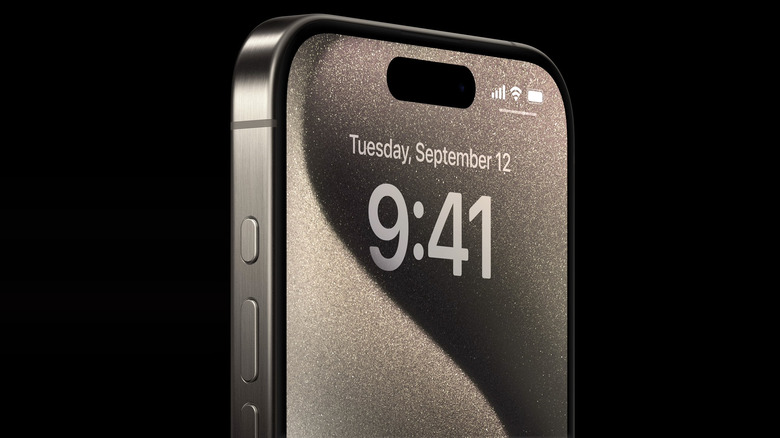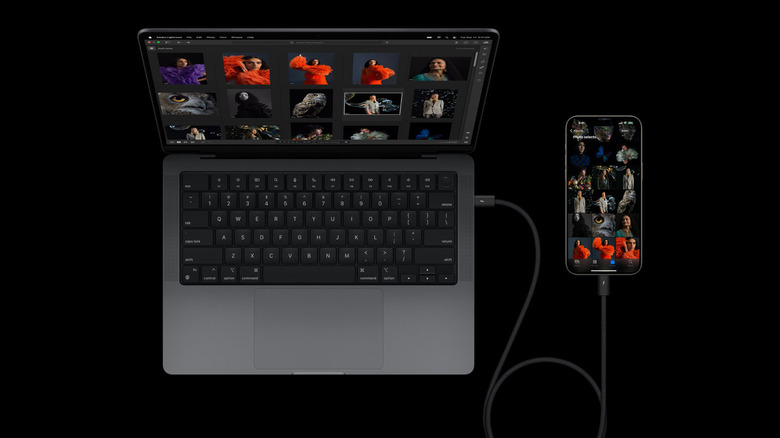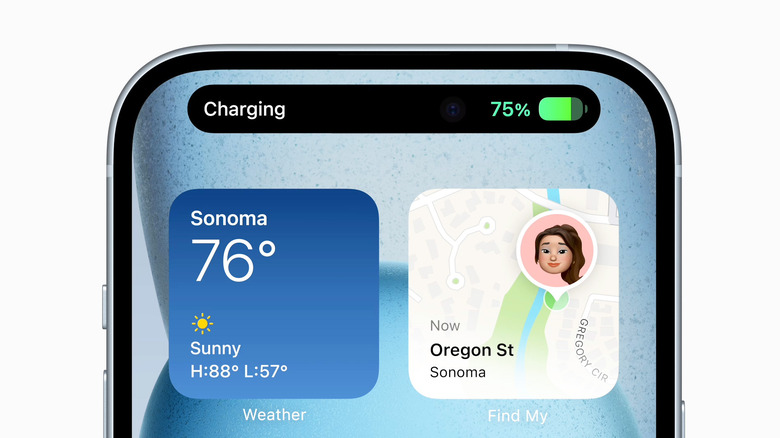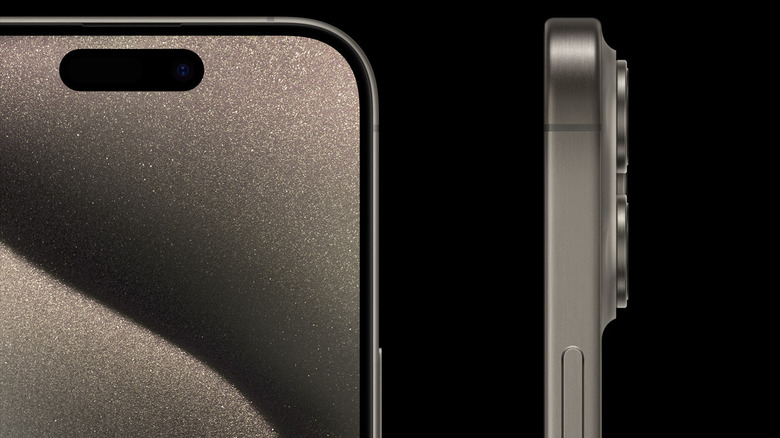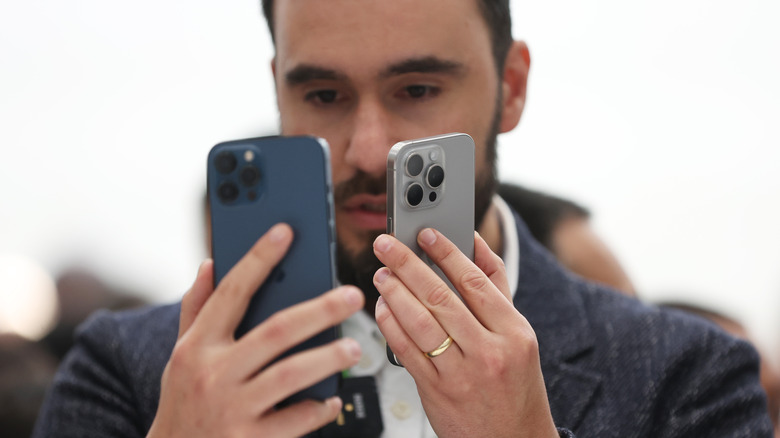Should You Really Buy The iPhone 15?
We may receive a commission on purchases made from links.
Like clockwork, the beginning of September brings shorter days, more brisk weather, and news of the latest iPhone. Apple announced the iPhone 15 series at a launch event streamed live from its headquarters in Cupertino, California. The presentation was both highly anticipated and fairly predictable, with some news expected — there's a new port in town — and leaked well in advance. Other updates proved more incremental or playing catch-up to what Android phones like the Samsung Galaxy S23 Ultra.
Are the improvements enough to make the iPhone 15 series worth the upgrade? It's a good question, especially since the base price of the iPhone 15 Pro has increased slightly. We delve deep into what's new with the phone's hardware and design and compare the iPhone 15 to its predecessor and Android phones so you can gauge whether it's worth making the switch from an earlier version of the iPhone or taking the plunge on buying an iPhone today.
Design
Let's face it: When we're talking about a smartphone, it's getting increasingly challenging to have innovative design short of introducing foldable displays as on the Samsung Galaxy Z Fold 5. On the surface, the iPhone 15 looks very similar to its predecessor. But there are some subtle differences. The sides have more rounded edges at the top and bottom, which, in turn, might make the phone sit more comfortably in your hand.
The back cover glass has a matte finish and comes in an array of new colors, with the selection different between the iPhone 15 and iPhone 15 Plus (pink, yellow, green, blue, and black) and the iPhone 15 Pro and iPhone 15 Pro Max (black titanium, white titanium, blue titanium, and natural titanium). While it may seem like a small point, the color differences emphasize the Pro models as being beefier and more, well, professional than the casual baseline and Plus models.
The iPhone 15 and iPhone 15 Plus have aluminum construction, while the iPhone 15 Pro and iPhone Pro Max use aerospace-grade titanium, which helps shave a smidgeon off the weight. Both have a ceramic shield to provide durability. Like the iPhone 14, the iPhone 15 has a dust and water resistance rating of IP68.
More on the design and display
The iPhone 15 Pro models go one step further than simply adding contoured edges. The Pro models ditch the venerable mute/silent slider switch (still found on the iPhone 15 and iPhone 15 Plus) to provide a new customizable Action Button. Apple says the button can handle a variety of tasks, from shortcuts you create to specific actions like opening the camera, turning on the flashlight, or muting the phone.
The displays are largely the same, with a 6.1-inch OLED screen on the iPhone 15 and 15 Pro and a 6.7-inch OLED screen on the 15 Plus and 15 Pro Max. The cheaper models get a 60Hz refresh rate screen, while the Pro series retains a 120Hz refresh rate, as was the case last year. One difference: The iPhone 15 and iPhone 15 Plus have a peak brightness of up to 2,000 nits, which is twice that of the iPhone 14 series.
The biggest physical change of all lies was completely expected: The iPhone 15 is the first iPhone with a USB-C port. This long-awaited change brings the iPhone in line with all other modern Android phones and brings unity within Apple's own product line since all current iPads and MacBooks have USB-C ports.
Now with USB-C
The iPhone 15's introduction of USB-C isn't because Apple had an epiphany that it was a better choice for consumers. Nor was it because it was past time to phase out the aging, slow Lightning interface launched in 2012.
This design change reflects the European Union forcing Apple's hand in an unprecedented ruling by the European Parliament adopting the USB-C interconnect as the standard for mobile charging in all mobile devices. The ruling required a common charging port for new phones starting in the fall of 2024. Apple, to its credit, beat that by a year. (Laptop makers have until 2026 to comply, while 13 other gadget categories, including e-readers and earbuds, have until fall 2024. This is also why Apple unveiled the new AirPods Pro with USB-C.)
The EU — the first global body to require a change in tech gear — pushed for this reform to save money for consumers and make our lives easier by having just one interconnect to rule them all.
USB-C speed variances
Not all iPhone 15 USB-C ports are equal since transfer speeds and protocols can vary even when using a USB-C interconnect. The iPhone 15 and iPhone 15 Plus only support 480Mbps data transfers, which matches the speed of the USB 2.0 standard. The iPhone 15 Pro and iPhone 15 Pro Max both support the 10Gbps data transfer standard of USB 3.0 (but not the faster-still 40Gbps standards of USB 4.0 and Thunderbolt 4, which also uses the USB-C interconnect), though you'll need a cable that Apple won't include in the box.
While faster is always better, that's still going to make a big difference in how long it takes to transfer high-res images and 4K video–assuming Apple's storage and iOS are optimized to handle such heavy-duty workflows. You can use the port to connect directly to an external drive.
Furthermore, there's the issue of USB PD or USB Power Delivery. Note that having a USB-C interconnect only solves part of the problem, though: Different cables may be necessary for achieving different data speeds or power output (for example, beefier laptops may need a 100W USB cable to properly use USB PD). Conveniently, in a pinch, you can use the USB port to charge other devices, though, like an Apple Watch or AirPods Pro earbuds.
Software: Dynamic Island for all
We've covered some of the new things coming in iOS 17 previously. However, the big news for the iPhone 15 and the iPhone 15 Plus is that it gains Dynamic Island. The Dynamic Island was introduced last year, but only in the iPhone 14 Pro series. Dynamic Island is Apple's way of disguising/replacing the infamous front-facing camera notch by incorporating it into the iOS so even third-party apps can take advantage of the additional space. The so-called island fluidly expands and adapts depending on what feature you're currently using.
Apple implements Dynamic Island by allowing you to expand an activity to access more detail, collapse the pop-up to make it smaller, and switch between two activities. Apple's own features that support Dynamic Island include FaceID, Apple Pay, AirPods, battery status, Apple Maps navigation, song playback, notifications, call management, voice memos, and Apple Watch unlocking.
Cameras: All about the zoom
The iPhone series remains split in its imaging capabilities, with the Pro series being the go-to for a more "professional" grade camera system. The iPhone 15 and 15 Plus gain a 48MP rear camera found in the Pro series, and it finally has a 2x optical telephoto lens in addition to its 0.5x ultrawide lens. However, the Pro series' 48MP camera uses a larger sensor than the iPhone 15/15 Plus line. The default shooting mode is actually 24MP, double the 12MP of the iPhone 14; this approach uses a process called pixel-binning. The 48MP mode works for both HEIF and ProRAW images.
Meanwhile, the iPhone 15 Pro gets a 3x optical lens in addition to the 2x optical lens, while the iPhone 15 Pro Max gets a "tetraprism" periscope lens that achieves a 5x optical zoom in addition to its 2x optical zoom. Both also have a 0.5x ultrawide lens.
In all, the iPhone 15 Pro Max offers an impressive array of focal lengths, with four optical lens capabilities (0.5x, 1x, 2x, and 5x). The main 1x camera is capable of three focal lengths (24mm, 28mm, and 35mm), while the 2x option delivers 48mm, and the 5x delivers 120mm — that's better than before but far short of the 230mm reach of the Samsung Galaxy S23 Ultra's 10x optical lens.
Cameras: New video features
The iPhone 15 Pro Max's video recording adds Log video recording (a flat format that preserves more detail and image information) and support for the Academy Color Encoding System, a Hollywood industry standard color profile for movies and television. These video recording additions provide greater creative control for filmmakers. Considering Apple's tight ties to Hollywood, it's not surprising that the company would add these features, as they enhance the viability of using an iPhone to capture professional content.
Thanks to the new phones' processing power, the iPhone 15 Pro series can capture spatial videos that can be viewed on the Apple Vision Pro headset due out in early 2024. In its launch event, Apple explained that it's using the ultrawide and main cameras together to create three-dimensional videos. The feature won't be available until "later this year," unsurprising given the early 2024 release plans for the Vision Pro headset.
Apple didn't mention whether there will be a way to view the videos outside of the Vision Pro environment. Without alternative ways to consume these videos, their usefulness may be limited, at least until the Apple Vision Pro becomes mainstream. On the other hand, the inclusion of spatial image capture is a stroke of brilliance because it means Apple is seeding the market with the tools to create content for Vision Pro.
Processor and battery
The iPhone 15 Pro series moves to the A17 Pro chip from the A16 Bionic chip, while the iPhone 15 and iPhone 15 Plus stay in the Bionic chip lineup and move to the more recent-gen A16 Bionic that was in the iPhone 14 Pro series.
It's easy to say, and correctly assume, that all iPhone 15 handsets will show a performance bump of some sort, whether it's in terms of snappy handling or how long it takes to edit a video. According to Apple, the baseline iPhones now have a more power-efficient processor with a better Neural engine, enough oomph to boost computational photography performance, and to support features like iOS 17's live voicemail transcription, for example.
The real performance boost comes in gaming and graphics handling on the Pro series phones. Notably, the Pro series' A17 Pro chip represents a significant graphics subsystem redesign so the GPU and Apple's Neural engine can work together, so the Pro phones support graphics upscaling and hardware-accelerated ray tracing. These features are common in modern graphics cards from Nvidia. The iPhone gains a sixth GPU, and Apple claims GPU performance is 20% faster.
In addition to the processor, GPU, and Neural engine improvements, the Pro series gains fast Wi-Fi 6E and Thread networking capabilities. Thread is a nascent, low-power mesh networking standard, poised to become more important in the coming months as more products come into the market.
There's not much news regarding batteries beyond Apple billing "all-day" battery life once more and similar estimates for battery life. The USB-C port makes charging easier, though.
Price and availability
Most of the new iPhones are keeping the same price as their predecessors. The iPhone 15 starts at $799, and the iPhone 15 Plus starts at $899. Both of those prices are for a 128GB model, and you can scale capacity up to 512GB. (Although, if you have extra bucks to spend, we'd suggest putting them towards a Pro model instead.)
The iPhone 15 Pro starts at $999 for the 128GB model, as did the iPhone 14 Pro. But the iPhone 15 Pro Max starts at $1,199, a $100 jump over the iPhone 14 Pro Max, though storage starts at 256GB by default now for what it's worth. Granted, the iPhone 14 Pro series' pricing was consistent with pre-pandemic pricing, but those price hikes still feel like a gutsy move on Apple's part in the current economic climate.
You can pre-order the phones from Apple, Verizon, T-Mobile, AT&T, and Best Buy as of Friday, September 15, starting at 5 a.m. PDT / 8 a.m. EDT. The phones ship on Friday, September 22.
How does it compare?
The iPhone 15's base price remains the same, as does its storage options. This feels appropriate vis-à-vis the Android competition. The iPhone 15 also plays catch up to Android phones by introducing additional optical lenses and boosting its camera resolution. In fact, with 24MP now the default resolution, that puts the iPhone 15 ahead of many competitors, including the Samsung Galaxy S23 line.
The iPhone 15 Pro Max starts at a higher price than before, but you're also getting more memory than before, so it's a wash–assuming you were willing to step up your memory buy on the flagship Pro Max model. That makes sense, given how quickly space fills when shooting ProRAW images or 4K videos. It's priced at the same level as Samsung's Galaxy S23 Ultra, which starts at 256GB for $1,199.
The iPhone 15 series is competitive in price except when you get to the premium Pro Max level. Its features are solid, yes, but the Pro series still lags behind many Android models, including the Samsung Galaxy S23 Ultra, in terms of optical zoom capabilities. The Pro Max differentiates itself with niche video production features and the potential for the still-unreleased spatial imaging feature.
Meanwhile, the iPhone 14 drops in price by $100, with the baseline model starting at $699 and the Plus starting at $799. A Benjamin might be worth the savings for those in need of an iPhone on a budget, but if you can swing the extra expense, go for an iPhone 15. All new and innovative iPhone accessories moving forward will be attuned to the USB-C ecosystem. Lightning won't go away overnight, but the iPhone's future is clearly USB-C.
Why go Pro?
Whether you should go for the Pro line really depends on your needs and how you use your phone. The Pro is all about cameras and speed — as in, the speed of data transfers using a cable connection.
If you need a basic iPhone for communications (phone, FaceTime, messaging) and the occasional snap, then the iPhone 15 or iPhone 15 Plus should suffice. But if you're someone who likes to push your phone's abilities to the limits and plan to use the camera heavily and capture lots of content, then the Pro line is for you. With the Pro, you get better camera performance and a super-zoom lens. This means if you're out and about and want to get close to the action, you can use the camera that's in your pocket and get a more satisfying result.
Perhaps even more critically, only the Pro series supports USB-C data transfers at 10Gbps. That's more than twice the speed supported by the USB-C port on the iPhone 15 and iPhone 15 Plus. It's also twice what the Lightning port can handle. This speed difference can be critical if you need to offload a 512GB phone's worth of images to a Mac or PC without involving the cloud.
Bottom line: The Pro series has the most benefits and technological innovation over the iPhone 14. If you can swing the cost, the iPhone 15 Pro Max is packed with the most differentiation of all the new iPhones.
Is it worth the upgrade?
So, is the new iPhone 15 series worth an upgrade? It depends on what's important to you and how good of a deal you can get from your carrier. After all, the iPhone 14 remains available, starting at $100 less than the iPhone 15. It's not as if the iPhone 14 has become useless technology overnight.
If you're the sort who's already deep into the USB-C ecosystem and you've craved to keep just one cable in your kit for all of your devices, then yes, you'll get value out of taking the plunge to any of the iPhone 15 models. You can't underestimate the sheer convenience and utility of having USB-C on board.
If your current phone's performance isn't bothering you, though, and the features enabled by the processor upgrades for the iPhone 15 series aren't enticing, then an upgrade may not feel warranted. But if you want to maximize your ability to do computational photography and use features like live voicemail transcription, you'll want to upgrade. And if you're a gamer, videographer, or imaging enthusiast who values graphics performance and the camera, then you'll really want to reap the benefits of the upgrade to the iPhone 15 Pro Max.
Finally, if you're using an older-generation iPhone, this might finally be the time to make a switch. You get better cameras and graphics performance across all varieties of iPhone 15, plus you can benefit from the switch to USB-C. And if you're still on an iPhone 8, iPhone 8 Plus, or iPhone X, your OS updates are at an end since iOS 17 won't support those models.
Still on the fence? Stay tuned to SlashGear, as we'll have full reviews of each iPhone model soon.


